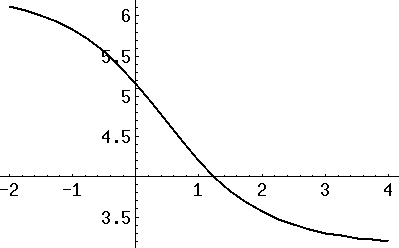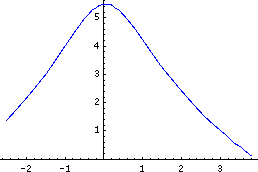
DSolve[ y''[t]==3-y[t], y[t], t ]
{{y[t] -> 3 + C[2]*Cos[t] - C[1]*Sin[t]}}
soln = NDSolve[ {y'[t] == Sin[y[t]], y[1]==4.2}, y, {t, -2, 4} ]
{{y -> InterpolatingFunction[{-2., 4.}, ... }}
How do you use ``InterpolatingFunction''? It can give you specific
numerical values (approximations, of course) and graphs. Using
soln[[1]] from the solution above,
Table[ {x, y[x], y'[x]} /. soln[[1]], {x,-1,3,0.5} ] // TableForm
- 1 5.82839 -0.439294
- 0.5 5.55424 -0.666085
0. 5.16022 -0.901381
0.5 4.67599 -0.999343
1. 4.2 -0.87127
1.5 3.82336 -0.630159
2. 3.56544 -0.411271
2.5 3.40112 -0.256627
Plot[ y[x] /. soln[[1]], {x,-2,4} ];

gensoln = DSolve[ x y'[x] + 2y[x] == Sin[x], y[x], x]
C[1] -(x Cos[x]) + Sin[x]
{{y[x] -> ---- + --------------------}}
2 2
x x
onesoln = gensoln[[1]] /. C[1]->1.3;
y[x_] = y[x] /. onesoln
trajectory = Plot[ y[x], {x,1,10}, PlotRange->All,
PlotStyle->{Hue[0.67]}];
1.3 -(x Cos[x]) + Sin[x]
--- + --------------------
2 2
x x

Needs["Graphics`PlotField`"];
field = PlotVectorField[ {1, (Sin[x]-2y)/x},
{x, 0.1, 10}, {y, -1, 2}];

Show[ field, trajectory ];

Needs["Graphics`PlotField`"];
The differential equation x(t) y(t)'+2y(t) = sin(x(t)) can be set up as a set of two equations in terms of the independent parameter t, one for x'(t) and one for y'(t):
eq1 = x'[t] == y[t];
eq2 = y'[t] == (Sin[x[t]]-2y[t])/x[t];
Here's how to show a representation of the associated field. Let's
show it for values of 1<x<5 and -1<y<2:
field = PlotVectorField[ {y, Sin[x]-2y)/x}, {x,1,5, 0.25}, {y,-1,2, 0.2}];

Now, one particular solution, obeying this differential equation plus the initial conditions x(0)=3 and y(0)=1, can be displayed using ParametricPlot. First solve the ODE numerically. We must give an explicit range for the parameter t; the range -0.5<t<15 gives a nice solution and picture. (Hue 0.67 is blue.)
nsoln = NDSolve[ {eq1, eq2, x[0]==3, y[0]==1}, {x,y}, {t, -0.5, 15}];
trajectory = ParametricPlot[ {x[t], y[t]} /. nsoln[[1]], {t, -0.5, 15},
PlotRange->All, PlotStyle->{Hue[0.67]}];

The two graphics above can be shown together, using Show. Note that the specific solution for the given initial conditions (trajectory) fits with the general solution (field).
Show[trajectory, field];

eq1 = x'[t] == y[t];
eq2 = y'[t] == (1/(1+x[t]^2)^2-4x[t] y[t])/(1+x[t]^2)
Here's a nice picture of the field defined by these equations:
field = PlotVectorField[ {y, (1/(1+x^2)^2-4x y)/(1+x^2)},
{x,-4,4, 0.5}, {y,0,7, 0.5}];

Solving for initial conditions, say, x(0)=3 and y(0)=1, and displaying the trajectory {x(t), y(t)} parametrically in blue,
nsoln = NDSolve[ {eq1, eq2, x[0]==3, y[0]==1}, {x,y}, {t, -2, 2}];
trajectory = ParametricPlot[ {x[t], y[t]} /. nsoln[[1]], {t, -2, 2},
PlotRange->All, PlotStyle->{Hue[0.67]}];

Show the general field and the specific solution together:
Show[trajectory, field];
